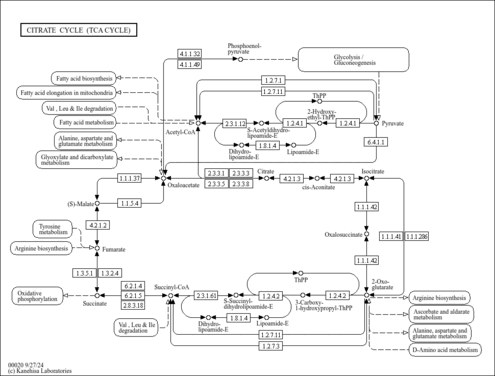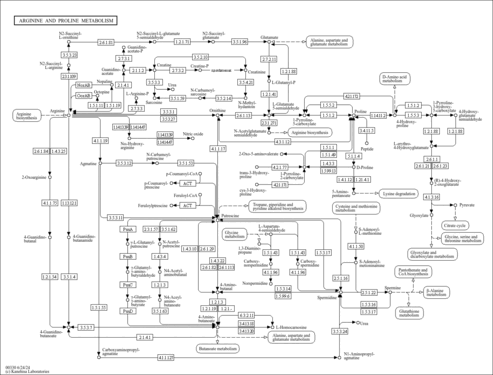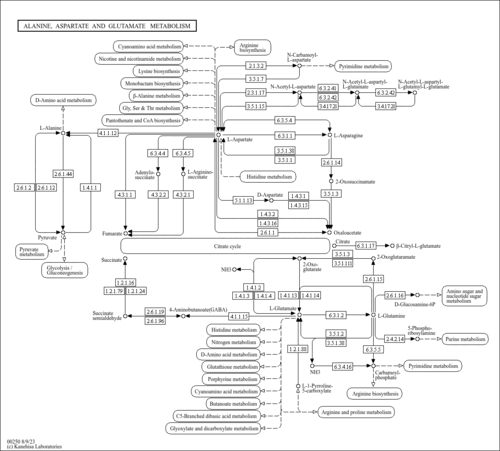| GC-MS Spectra| Spectrum Type | Description | Splash Key | Deposition Date | Source | View |
|---|
| Predicted GC-MS | Predicted GC-MS Spectrum - Hydrogen carbonate GC-MS (Non-derivatized) - 70eV, Positive | splash10-03di-9000000000-310dbbc64fba7d9c667e | 2016-09-22 | Wishart Lab | View Spectrum | | Predicted GC-MS | Predicted GC-MS Spectrum - Hydrogen carbonate GC-MS (2 TMS) - 70eV, Positive | splash10-00du-9300000000-b9ab1da5629a3dfff55f | 2017-10-06 | Wishart Lab | View Spectrum | | Predicted GC-MS | Predicted GC-MS Spectrum - Hydrogen carbonate GC-MS (Non-derivatized) - 70eV, Positive | Not Available | 2021-10-12 | Wishart Lab | View Spectrum | | Predicted GC-MS | Predicted GC-MS Spectrum - Hydrogen carbonate GC-MS (TMS_1_1) - 70eV, Positive | Not Available | 2021-11-05 | Wishart Lab | View Spectrum | | Predicted GC-MS | Predicted GC-MS Spectrum - Hydrogen carbonate GC-MS (TBDMS_1_1) - 70eV, Positive | Not Available | 2021-11-05 | Wishart Lab | View Spectrum | | Predicted GC-MS | Predicted GC-MS Spectrum - Hydrogen carbonate GC-MS (TBDMS_2_1) - 70eV, Positive | Not Available | 2021-11-05 | Wishart Lab | View Spectrum |
MS/MS Spectra| Spectrum Type | Description | Splash Key | Deposition Date | Source | View |
|---|
| Predicted LC-MS/MS | Predicted LC-MS/MS Spectrum - Hydrogen carbonate 10V, Positive-QTOF | splash10-03di-9000000000-53429210d3161a8e792f | 2015-09-14 | Wishart Lab | View Spectrum | | Predicted LC-MS/MS | Predicted LC-MS/MS Spectrum - Hydrogen carbonate 20V, Positive-QTOF | splash10-03di-9000000000-65bbb10c2768f3746b62 | 2015-09-14 | Wishart Lab | View Spectrum | | Predicted LC-MS/MS | Predicted LC-MS/MS Spectrum - Hydrogen carbonate 40V, Positive-QTOF | splash10-03di-9000000000-b6afca3e3ac002546879 | 2015-09-14 | Wishart Lab | View Spectrum | | Predicted LC-MS/MS | Predicted LC-MS/MS Spectrum - Hydrogen carbonate 10V, Negative-QTOF | splash10-03di-9000000000-0ef3797aeb5276c64c90 | 2015-09-15 | Wishart Lab | View Spectrum | | Predicted LC-MS/MS | Predicted LC-MS/MS Spectrum - Hydrogen carbonate 20V, Negative-QTOF | splash10-03di-9000000000-5b50453541e6f14e35be | 2015-09-15 | Wishart Lab | View Spectrum | | Predicted LC-MS/MS | Predicted LC-MS/MS Spectrum - Hydrogen carbonate 40V, Negative-QTOF | splash10-03di-9000000000-5b50453541e6f14e35be | 2015-09-15 | Wishart Lab | View Spectrum | | Predicted LC-MS/MS | Predicted LC-MS/MS Spectrum - Hydrogen carbonate 10V, Negative-QTOF | splash10-03di-9000000000-3142be69389832d3eb4b | 2021-09-21 | Wishart Lab | View Spectrum | | Predicted LC-MS/MS | Predicted LC-MS/MS Spectrum - Hydrogen carbonate 20V, Negative-QTOF | splash10-03di-9000000000-3142be69389832d3eb4b | 2021-09-21 | Wishart Lab | View Spectrum | | Predicted LC-MS/MS | Predicted LC-MS/MS Spectrum - Hydrogen carbonate 40V, Negative-QTOF | splash10-03di-9000000000-3142be69389832d3eb4b | 2021-09-21 | Wishart Lab | View Spectrum | | Predicted LC-MS/MS | Predicted LC-MS/MS Spectrum - Hydrogen carbonate 10V, Positive-QTOF | splash10-03di-9000000000-65a6c4ac46a60ccd0a02 | 2021-09-25 | Wishart Lab | View Spectrum | | Predicted LC-MS/MS | Predicted LC-MS/MS Spectrum - Hydrogen carbonate 20V, Positive-QTOF | splash10-0006-9000000000-75ba60e3edf4ccfcfbe0 | 2021-09-25 | Wishart Lab | View Spectrum | | Predicted LC-MS/MS | Predicted LC-MS/MS Spectrum - Hydrogen carbonate 40V, Positive-QTOF | splash10-0006-9000000000-a1e091bb1f5fa6e9cbc7 | 2021-09-25 | Wishart Lab | View Spectrum |
NMR Spectra| Spectrum Type | Description | Deposition Date | Source | View |
|---|
| Predicted 1D NMR | 13C NMR Spectrum (1D, 100 MHz, H2O, predicted) | 2022-08-18 | Wishart Lab | View Spectrum | | Predicted 1D NMR | 13C NMR Spectrum (1D, 1000 MHz, H2O, predicted) | 2022-08-18 | Wishart Lab | View Spectrum | | Predicted 1D NMR | 13C NMR Spectrum (1D, 200 MHz, H2O, predicted) | 2022-08-18 | Wishart Lab | View Spectrum | | Predicted 1D NMR | 13C NMR Spectrum (1D, 300 MHz, H2O, predicted) | 2022-08-18 | Wishart Lab | View Spectrum | | Predicted 1D NMR | 13C NMR Spectrum (1D, 400 MHz, H2O, predicted) | 2022-08-18 | Wishart Lab | View Spectrum | | Predicted 1D NMR | 13C NMR Spectrum (1D, 500 MHz, H2O, predicted) | 2022-08-18 | Wishart Lab | View Spectrum | | Predicted 1D NMR | 13C NMR Spectrum (1D, 600 MHz, H2O, predicted) | 2022-08-18 | Wishart Lab | View Spectrum | | Predicted 1D NMR | 13C NMR Spectrum (1D, 700 MHz, H2O, predicted) | 2022-08-18 | Wishart Lab | View Spectrum | | Predicted 1D NMR | 13C NMR Spectrum (1D, 800 MHz, H2O, predicted) | 2022-08-18 | Wishart Lab | View Spectrum | | Predicted 1D NMR | 13C NMR Spectrum (1D, 900 MHz, H2O, predicted) | 2022-08-18 | Wishart Lab | View Spectrum |
IR Spectra| Spectrum Type | Description | Deposition Date | Source | View |
|---|
| Predicted IR Spectrum | IR Ion Spectrum (Predicted IRIS Spectrum, Adduct: [M-H]-) | 2023-02-03 | FELIX lab | View Spectrum | | Predicted IR Spectrum | IR Ion Spectrum (Predicted IRIS Spectrum, Adduct: [M+H]+) | 2023-02-03 | FELIX lab | View Spectrum | | Predicted IR Spectrum | IR Ion Spectrum (Predicted IRIS Spectrum, Adduct: [M+Na]+) | 2023-02-03 | FELIX lab | View Spectrum |
| Show more...
|---|
| Disease References | | Hawkinsinuria |
|---|
- G.Frauendienst-Egger, Friedrich K. Trefz (2017). MetaGene: Metabolic & Genetic Information Center (MIC: http://www.metagene.de). METAGENE consortium.
| | Renal tubular acidosis, distal, RTA type 1 |
|---|
- Karet FE, Gainza FJ, Gyory AZ, Unwin RJ, Wrong O, Tanner MJ, Nayir A, Alpay H, Santos F, Hulton SA, Bakkaloglu A, Ozen S, Cunningham MJ, di Pietro A, Walker WG, Lifton RP: Mutations in the chloride-bicarbonate exchanger gene AE1 cause autosomal dominant but not autosomal recessive distal renal tubular acidosis. Proc Natl Acad Sci U S A. 1998 May 26;95(11):6337-42. [PubMed:9600966 ]
| | 2-Ketoglutarate dehydrogenase complex deficiency |
|---|
- Guffon N, Lopez-Mediavilla C, Dumoulin R, Mousson B, Godinot C, Carrier H, Collombet JM, Divry P, Mathieu M, Guibaud P: 2-Ketoglutarate dehydrogenase deficiency, a rare cause of primary hyperlactataemia: report of a new case. J Inherit Metab Dis. 1993;16(5):821-30. [PubMed:8295396 ]
| | 21-Hydroxylase deficiency |
|---|
- Warinner SA, Zimmerman D, Thompson GB, Grant CS: Study of three patients with congenital adrenal hyperplasia treated by bilateral adrenalectomy. World J Surg. 2000 Nov;24(11):1347-52. [PubMed:11038205 ]
| | Bartter Syndrome, Type 4A, Neonatal, with Sensorineural Deafness |
|---|
- Zaffanello M, Taranta A, Palma A, Bettinelli A, Marseglia GL, Emma F: Type IV Bartter syndrome: report of two new cases. Pediatr Nephrol. 2006 Jun;21(6):766-70. doi: 10.1007/s00467-006-0090-x. Epub 2006 Apr 1. [PubMed:16583241 ]
- Heilberg IP, Totoli C, Calado JT: Adult presentation of Bartter syndrome type IV with erythrocytosis. Einstein (Sao Paulo). 2015 Oct-Dec;13(4):604-6. doi: 10.1590/S1679-45082015RC3013. Epub 2015 Oct 30. [PubMed:26537508 ]
| | 3-Hydroxy-3-methylglutaryl-CoA lyase deficiency |
|---|
- Santarelli F, Cassanello M, Enea A, Poma F, D'Onofrio V, Guala G, Garrone G, Puccinelli P, Caruso U, Porta F, Spada M: A neonatal case of 3-hydroxy-3-methylglutaric-coenzyme A lyase deficiency. Ital J Pediatr. 2013 May 24;39:33. doi: 10.1186/1824-7288-39-33. [PubMed:23705938 ]
| | Bartter Syndrome, Type 2, Antenatal |
|---|
- Chan WK, To KF, Tong JH, Law CW: Paradoxical hypertension and salt wasting in Type II Bartter syndrome. Clin Kidney J. 2012 Jun;5(3):217-20. doi: 10.1093/ckj/sfs026. Epub 2012 Mar 29. [PubMed:26069767 ]
| | Dihydrolipoamide Dehydrogenase Deficiency |
|---|
- Kuhara T, Shinka T, Inoue Y, Matsumoto M, Yoshino M, Sakaguchi Y, Matsumoto I: Studies of urinary organic acid profiles of a patient with dihydrolipoyl dehydrogenase deficiency. Clin Chim Acta. 1983 Sep 30;133(2):133-40. [PubMed:6688766 ]
| | Leigh's syndrome, subacute necrotizing encephalopathy, SNE |
|---|
- Hommes FA, Polman HA, Reerink JD: Leigh's encephalomyelopathy: an inborn error of gluconeogenesis. Arch Dis Child. 1968 Aug;43(230):423-6. [PubMed:4873809 ]
| | Pyruvate dehydrogenase phosphatase deficiency |
|---|
- Robinson BH, Sherwood WG: Pyruvate dehydrogenase phosphatase deficiency: a cause of congenital chronic lactic acidosis in infancy. Pediatr Res. 1975 Dec;9(12):935-9. doi: 10.1203/00006450-197512000-00015. [PubMed:172850 ]
| | Pseudohypoaldosteronism, type I, autosomal dominant |
|---|
- Bowden SA, Cozzi C, Hickey SE, Thrush DL, Astbury C, Nuthakki S: Autosomal dominant pseudohypoaldosteronism type 1 in an infant with salt wasting crisis associated with urinary tract infection and obstructive uropathy. Case Rep Endocrinol. 2013;2013:524647. doi: 10.1155/2013/524647. Epub 2013 Dec 19. [PubMed:24455331 ]
| | Congenital chloride diarrhea |
|---|
- Choi M, Scholl UI, Ji W, Liu T, Tikhonova IR, Zumbo P, Nayir A, Bakkaloglu A, Ozen S, Sanjad S, Nelson-Williams C, Farhi A, Mane S, Lifton RP: Genetic diagnosis by whole exome capture and massively parallel DNA sequencing. Proc Natl Acad Sci U S A. 2009 Nov 10;106(45):19096-101. doi: 10.1073/pnas.0910672106. Epub 2009 Oct 27. [PubMed:19861545 ]
| | Gitelman syndrome |
|---|
- Lin SH, Cheng NL, Hsu YJ, Halperin ML: Intrafamilial phenotype variability in patients with Gitelman syndrome having the same mutations in their thiazide-sensitive sodium/chloride cotransporter. Am J Kidney Dis. 2004 Feb;43(2):304-12. [PubMed:14750096 ]
| | Seizures, sensorineural deafness, ataxia, mental retardation, and electrolyte imbalance (SESAMES) |
|---|
- Scholl UI, Choi M, Liu T, Ramaekers VT, Hausler MG, Grimmer J, Tobe SW, Farhi A, Nelson-Williams C, Lifton RP: Seizures, sensorineural deafness, ataxia, mental retardation, and electrolyte imbalance (SeSAME syndrome) caused by mutations in KCNJ10. Proc Natl Acad Sci U S A. 2009 Apr 7;106(14):5842-7. doi: 10.1073/pnas.0901749106. Epub 2009 Mar 16. [PubMed:19289823 ]
| | Fanconi syndrome |
|---|
- Cheng HM, Jap TS, Ho LT: Fanconi syndrome: report of a case. J Formos Med Assoc. 1990 Dec;89(12):1115-7. [PubMed:1982686 ]
- McSherry E, Sebastian A, Morris RC Jr: Renal tubular acidosis in infants: the several kinds, including bicarbonate-wasting, classic renal tubular acidosis. J Clin Invest. 1972 Mar;51(3):499-514. [PubMed:5011097 ]
| | Monocarboxylate transporter 1 deficiency |
|---|
- Balasubramaniam S, Lewis B, Greed L, Meili D, Flier A, Yamamoto R, Bilic K, Till C, Sass JO: Heterozygous Monocarboxylate Transporter 1 (MCT1, SLC16A1) Deficiency as a Cause of Recurrent Ketoacidosis. JIMD Rep. 2016;29:33-38. doi: 10.1007/8904_2015_519. Epub 2015 Nov 26. [PubMed:26608392 ]
| | Carnitine palmitoyltransferase I deficiency |
|---|
- Olpin SE, Allen J, Bonham JR, Clark S, Clayton PT, Calvin J, Downing M, Ives K, Jones S, Manning NJ, Pollitt RJ, Standing SJ, Tanner MS: Features of carnitine palmitoyltransferase type I deficiency. J Inherit Metab Dis. 2001 Feb;24(1):35-42. [PubMed:11286380 ]
| | Renal tubular acidosis, proximal, with ocular abnormalities and mental retardation |
|---|
- Igarashi T, Ishii T, Watanabe K, Hayakawa H, Horio K, Sone Y, Ohga K: Persistent isolated proximal renal tubular acidosis--a systemic disease with a distinct clinical entity. Pediatr Nephrol. 1994 Feb;8(1):70-1. [PubMed:8142230 ]
| | Ketoacidosis |
|---|
- Snyderman SE, Sansaricq C, Middleton B: Succinyl-CoA:3-ketoacid CoA-transferase deficiency. Pediatrics. 1998 Apr;101(4 Pt 1):709-11. [PubMed:9521962 ]
| | Congenital secretory diarrhea |
|---|
- Muller T, Wijmenga C, Phillips AD, Janecke A, Houwen RH, Fischer H, Ellemunter H, Fruhwirth M, Offner F, Hofer S, Muller W, Booth IW, Heinz-Erian P: Congenital sodium diarrhea is an autosomal recessive disorder of sodium/proton exchange but unrelated to known candidate genes. Gastroenterology. 2000 Dec;119(6):1506-13. [PubMed:11113072 ]
| | Bartter Syndrome, Type 4B, Neonatal, With Sensorineural Deafness |
|---|
- Nozu K, Inagaki T, Fu XJ, Nozu Y, Kaito H, Kanda K, Sekine T, Igarashi T, Nakanishi K, Yoshikawa N, Iijima K, Matsuo M: Molecular analysis of digenic inheritance in Bartter syndrome with sensorineural deafness. J Med Genet. 2008 Mar;45(3):182-6. doi: 10.1136/jmg.2007.052944. [PubMed:18310267 ]
| | Bartter Syndrome, Type 5, Antenatal, Transient |
|---|
- Laghmani K, Beck BB, Yang SS, Seaayfan E, Wenzel A, Reusch B, Vitzthum H, Priem D, Demaretz S, Bergmann K, Duin LK, Gobel H, Mache C, Thiele H, Bartram MP, Dombret C, Altmuller J, Nurnberg P, Benzing T, Levtchenko E, Seyberth HW, Klaus G, Yigit G, Lin SH, Timmer A, de Koning TJ, Scherjon SA, Schlingmann KP, Bertrand MJ, Rinschen MM, de Backer O, Konrad M, Komhoff M: Polyhydramnios, Transient Antenatal Bartter's Syndrome, and MAGED2 Mutations. N Engl J Med. 2016 May 12;374(19):1853-63. doi: 10.1056/NEJMoa1507629. Epub 2016 Apr 27. [PubMed:27120771 ]
| | Leigh Syndrome, French Canadian Type |
|---|
- Debray FG, Morin C, Janvier A, Villeneuve J, Maranda B, Laframboise R, Lacroix J, Decarie JC, Robitaille Y, Lambert M, Robinson BH, Mitchell GA: LRPPRC mutations cause a phenotypically distinct form of Leigh syndrome with cytochrome c oxidase deficiency. J Med Genet. 2011 Mar;48(3):183-9. doi: 10.1136/jmg.2010.081976. Epub 2011 Jan 25. [PubMed:21266382 ]
| | Lipoyltransferase 1 Deficiency |
|---|
- Soreze Y, Boutron A, Habarou F, Barnerias C, Nonnenmacher L, Delpech H, Mamoune A, Chretien D, Hubert L, Bole-Feysot C, Nitschke P, Correia I, Sardet C, Boddaert N, Hamel Y, Delahodde A, Ottolenghi C, de Lonlay P: Mutations in human lipoyltransferase gene LIPT1 cause a Leigh disease with secondary deficiency for pyruvate and alpha-ketoglutarate dehydrogenase. Orphanet J Rare Dis. 2013 Dec 17;8:192. doi: 10.1186/1750-1172-8-192. [PubMed:24341803 ]
| | Myopathy, lactic acidosis, and sideroblastic anemia 1 |
|---|
- Parfait B, de Lonlay P, von Kleist-Retzow JC, Cormier-Daire V, Chretien D, Rotig A, Rabier D, Saudubray JM, Rustin P, Munnich A: The neurogenic weakness, ataxia and retinitis pigmentosa (NARP) syndrome mtDNA mutation (T8993G) triggers muscle ATPase deficiency and hypocitrullinaemia. Eur J Pediatr. 1999 Jan;158(1):55-8. [PubMed:9950309 ]
| | Fanconi Bickel syndrome |
|---|
- Nirupama Gupta, Bimota Nambam, David A. Weinstein, and Lawrence R. Shoemaker (2016). Late Diagnosis of Fanconi-Bickel Syndrome: Challenges With the Diagnosis and Literature Review . Journal of Inborn Errors of Metabolism and Screening.
|
|
|---|
| General References | - Gross E, Fedotoff O, Pushkin A, Abuladze N, Newman D, Kurtz I: Phosphorylation-induced modulation of pNBC1 function: distinct roles for the amino- and carboxy-termini. J Physiol. 2003 Jun 15;549(Pt 3):673-82. Epub 2003 May 2. [PubMed:12730338 ]
- Kristensen JM, Kristensen M, Juel C: Expression of Na+/HCO3- co-transporter proteins (NBCs) in rat and human skeletal muscle. Acta Physiol Scand. 2004 Sep;182(1):69-76. [PubMed:15329059 ]
- Severina IS, Pyatakova NV, Shchegolev AY, Ponomarev GV: YC-1-like potentiation of NO-dependent activation of soluble guanylate cyclase by derivatives of protoporphyrin IX. Biochemistry (Mosc). 2006 Mar;71(3):340-4. [PubMed:16545073 ]
- Bomhard EM, Brendler-Schwaab SY, Freyberger A, Herbold BA, Leser KH, Richter M: O-phenylphenol and its sodium and potassium salts: a toxicological assessment. Crit Rev Toxicol. 2002;32(6):551-625. [PubMed:12487365 ]
- Sepai O, Anderson D, Street B, Bird I, Farmer PB, Bailey E: Monitoring of exposure to styrene oxide by GC-MS analysis of phenylhydroxyethyl esters in hemoglobin. Arch Toxicol. 1993;67(1):28-33. [PubMed:8452476 ]
- DiGiovanna JJ, Aoyagi T, Taylor JR, Halprin KM: Inhibition of epidermal adenyl cyclase by lithium carbonate. J Invest Dermatol. 1981 Apr;76(4):259-63. [PubMed:6259263 ]
- Thakur SC, Thakur SS, Chaube SK, Singh SP: Subchronic supplementation of lithium carbonate induces reproductive system toxicity in male rat. Reprod Toxicol. 2003 Nov-Dec;17(6):683-90. [PubMed:14613820 ]
- Faravelli C, Di Bernardo M, Ricca V, Benvenuti P, Bartelli M, Ronchi O: Effects of chronic lithium treatment on the peripheral nervous system. J Clin Psychiatry. 1999 May;60(5):306-10. [PubMed:10362438 ]
- Siegel L, Walker SI, Robin NI: Total hydrolyzable glycerol in amniotic fluid, and its relationship to fetal lung maturity. Clin Chem. 1984 Sep;30(9):1546-8. [PubMed:6467568 ]
- Bartsch I, Zschaler I, Haseloff M, Steinberg P: Establishment of a long-term culture system for rat colon epithelial cells. In Vitro Cell Dev Biol Anim. 2004 Sep-Oct;40(8-9):278-84. [PubMed:15723563 ]
- Matousek P, Novotny J, Rudajev V, Svoboda P: Prolonged agonist stimulation does not alter the protein composition of membrane domains in spite of dramatic changes induced in a specific signaling cascade. Cell Biochem Biophys. 2005;42(1):21-40. [PubMed:15673926 ]
- Xu W, Yoon SI, Huang P, Wang Y, Chen C, Chong PL, Liu-Chen LY: Localization of the kappa opioid receptor in lipid rafts. J Pharmacol Exp Ther. 2006 Jun;317(3):1295-306. Epub 2006 Feb 27. [PubMed:16505160 ]
- Perrild H, Hegedus L, Arnung K: Sex related goitrogenic effect of lithium carbonate in healthy young subjects. Acta Endocrinol (Copenh). 1984 Jun;106(2):203-8. [PubMed:6428121 ]
- Sack DA, Sack RB, Nair GB, Siddique AK: Cholera. Lancet. 2004 Jan 17;363(9404):223-33. [PubMed:14738797 ]
- Loiselle FB, Jaschke P, Casey JR: Structural and functional characterization of the human NBC3 sodium/bicarbonate co-transporter carboxyl-terminal cytoplasmic domain. Mol Membr Biol. 2003 Oct-Dec;20(4):307-17. [PubMed:14578046 ]
- Antonijevic N, Terzic T, Jovanovic V, Suvajdzic N, Milosevic R, Basara N, Elezovic I: [Acquired amegakaryocytic thrombocytopenia: three case reports and a literature review]. Med Pregl. 2004 May-Jun;57(5-6):292-7. [PubMed:15503803 ]
- Chang TC: Influence of lithium carbonate on the thyrotropin receptor in vitro. Taiwan Yi Xue Hui Za Zhi. 1989 Jan;88(1):13-7. [PubMed:2547015 ]
- Arthurs CE, Jarvis GN, Russell JB: The effect of various carbonate sources on the survival of Escherichia coli in dairy cattle manure. Curr Microbiol. 2001 Sep;43(3):220-4. [PubMed:11400074 ]
- Piepho RW, Culbertson VL, Rhodes RS: Drug interactions with the calcium-entry blockers. Circulation. 1987 Jun;75(6 Pt 2):V181-94. [PubMed:2882874 ]
- Saran AS: Antidiabetic effects of lithium. J Clin Psychiatry. 1982 Sep;43(9):383-4. [PubMed:6811566 ]
- Amsterdam JD, Maislin G, Rybakowski J: A possible antiviral action of lithium carbonate in herpes simplex virus infections. Biol Psychiatry. 1990 Feb 15;27(4):447-53. [PubMed:2155671 ]
- Gultekin I, Ince NH: Ultrasonic destruction of bisphenol-A: the operating parameters. Ultrason Sonochem. 2008 Apr;15(4):524-9. Epub 2007 Jun 10. [PubMed:17644462 ]
- Medinas DB, Cerchiaro G, Trindade DF, Augusto O: The carbonate radical and related oxidants derived from bicarbonate buffer. IUBMB Life. 2007 Apr-May;59(4-5):255-62. [PubMed:17505962 ]
- Casey JR: Why bicarbonate? Biochem Cell Biol. 2006 Dec;84(6):930-9. [PubMed:17215880 ]
- (). Duke, James A. (1992) Handbook of phytochemical constituents of GRAS herbs and other economic plants. Boca Raton, FL. CRC Press.. .
| Show more...
|---|


